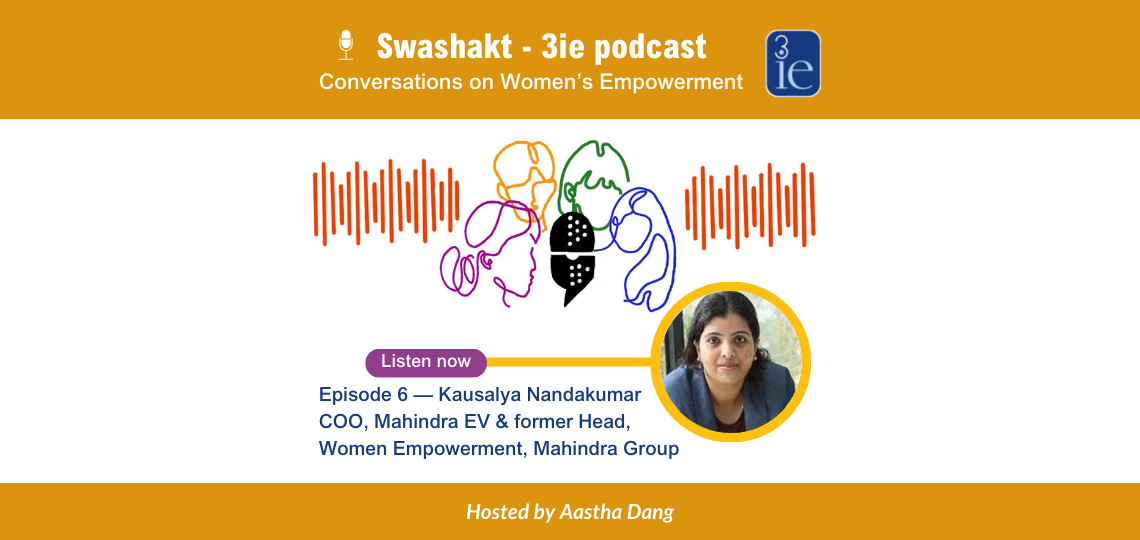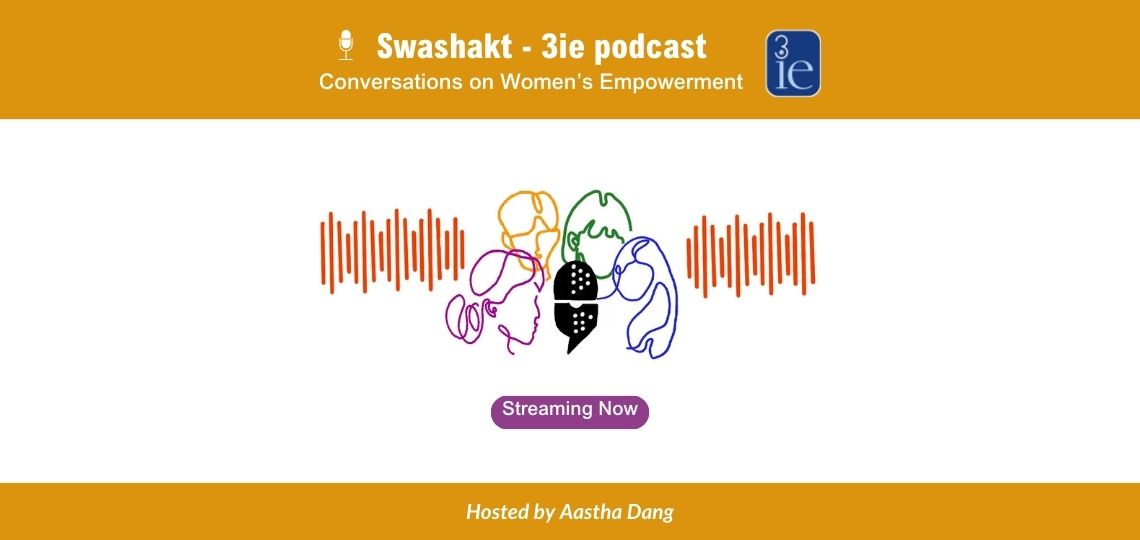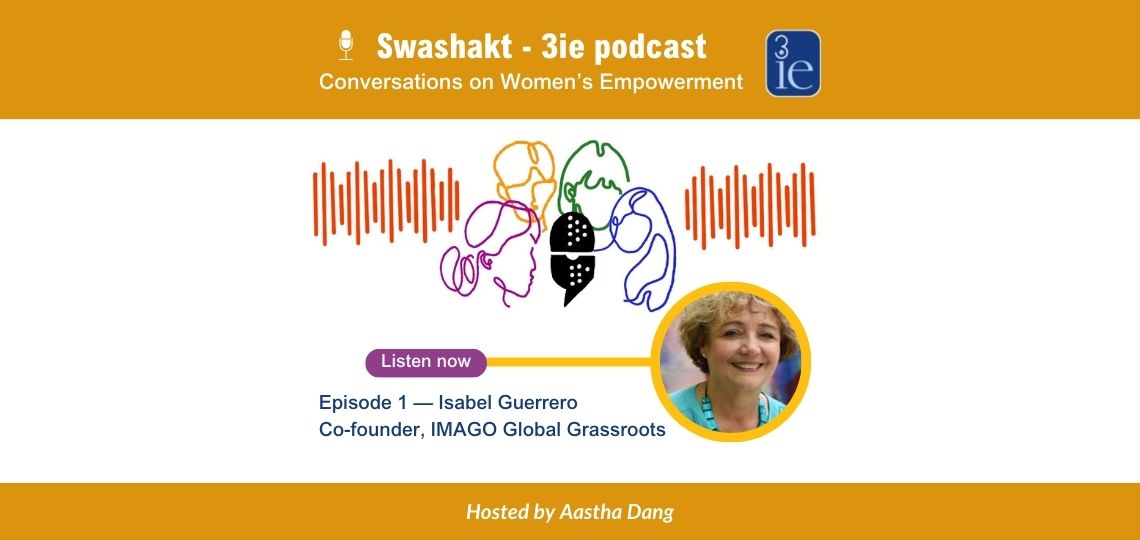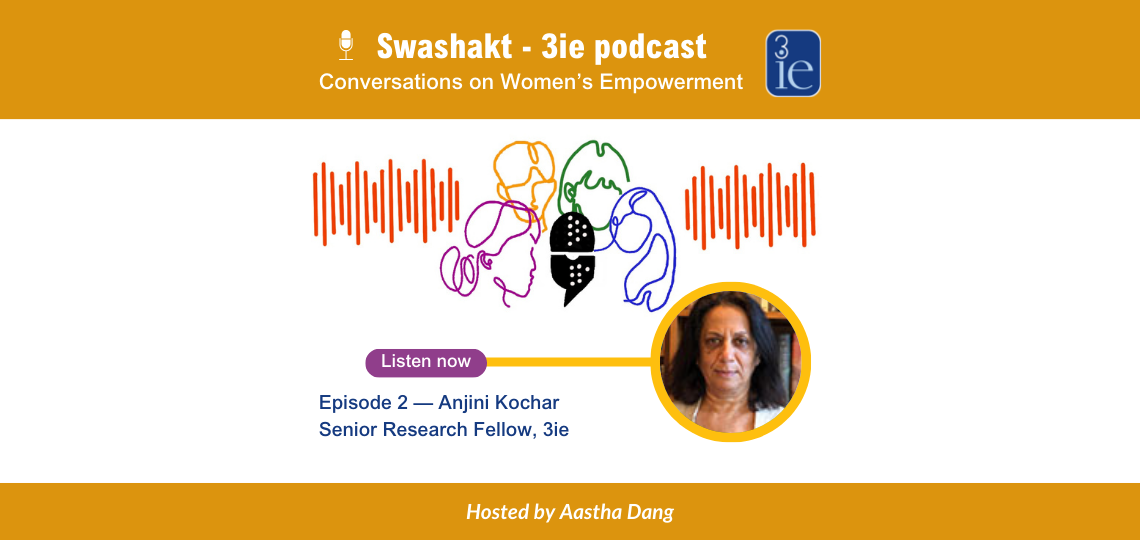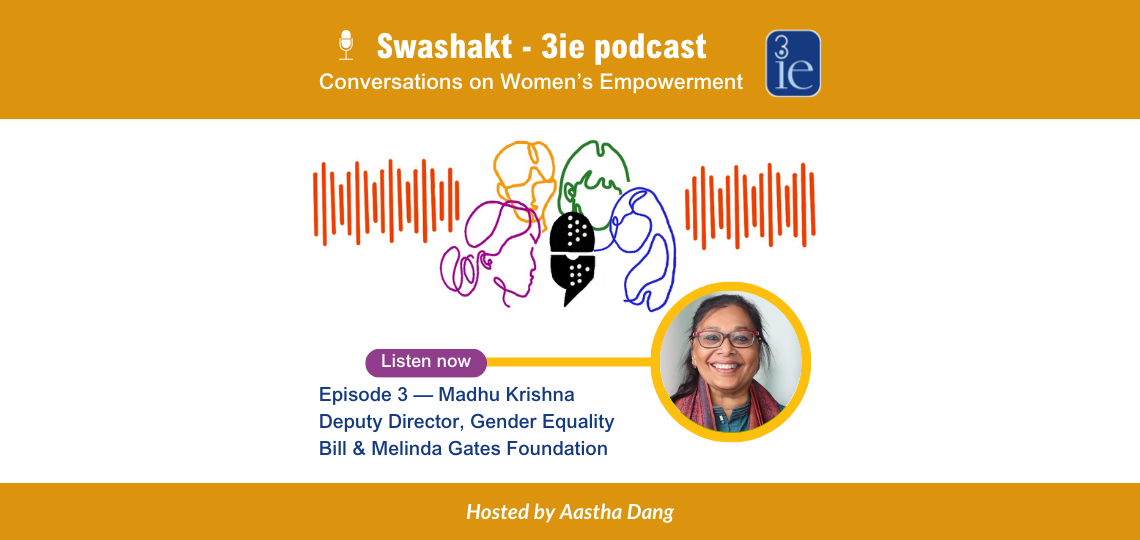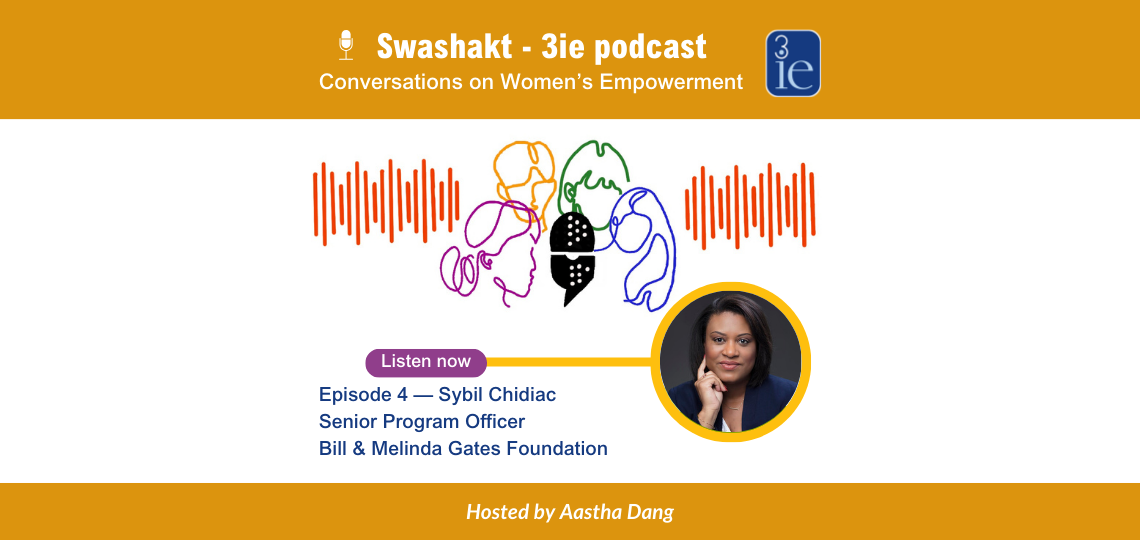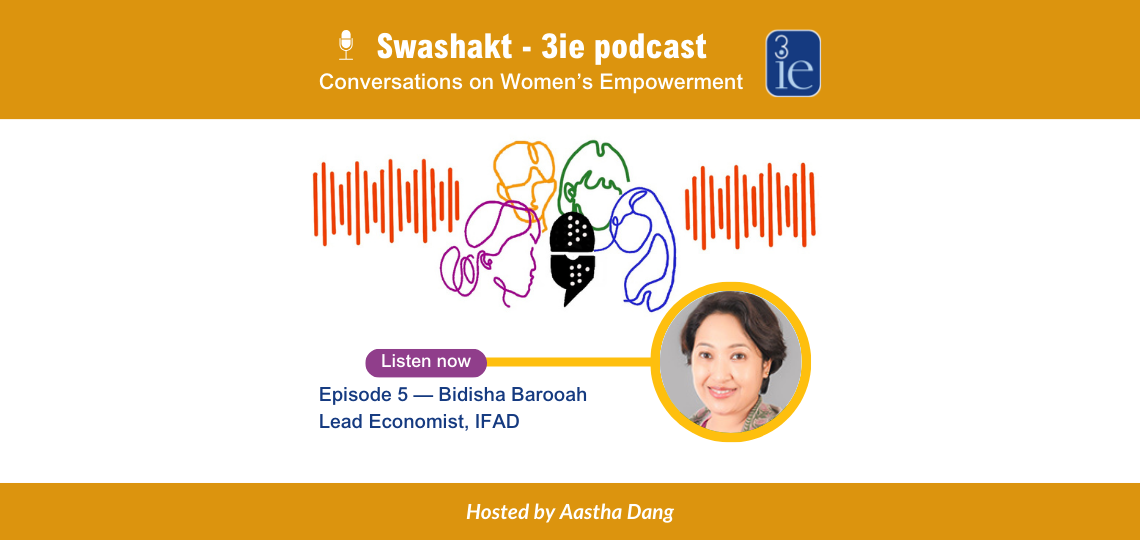Private sector, a lead catalyst to enable change - with Kausalya Nandakumar
About the episode
In the final episode of the Swashakt podcast, 3ie evaluation specialist Aastha Dang speaks to Kausalya Nandakumar, who is the former head of women’s empowerment at the Mahindra Group and now oversees the company’s EV division. Nandakumar explains why she believes economic empowerment is the key gateway to women’s overall empowerment. Listen to this episode to know Nandakumar’s views about how the private sector can play the role of a lead catalyst to enable change from within so that women are not just able to get a job but are able to thrive and succeed in it.
This podcast series has been produced by the International Initiative for Impact Evaluation (3ie) and is inspired by our Swashakt evidence program and our Rural India Livelihoods Project. The views expressed are those of the speakers and do not necessarily reflect positions or policies of 3ie.
Host: Aastha Dang
Production lead: Kirthi V Rao, Tanvi
Production support: Annie Vincent, Durgadas Menon, Shailendra
Disclaimer: The podcast has been edited for clarity.
[Intro]
Aastha: The world is not on track to achieving the Sustainable Development Goal #5 on gender equality and women's empowerment. Where have we reached and how far do we need to go? While data can throw light on this question, there is no substitute for the wisdom of practitioners. Join us for this podcast series as we try to understand empowerment better and explore the pathways towards economic empowerment, in particular self empowerment for women who are part of collectives in low- and middle-income countries. We are talking to a series of women whose training and experience can act like beacons on this journey.
I am Aastha Dang, evaluation specialist at 3ie. In today's episode, I'm speaking to Kausalya Nandakumar, who was then the Head of Women's Empowerment at the Mahindra Group. She was earlier the CEO of Smart Shift, Mahindra Group's first intrapreneurial venture. Kausalya has more than 17 years of experience across various roles in business management, strategy, brand, sales and market research.[Access to resources essential for empowerment]
Aastha: Welcome to the podcast Kausalya, I'll come straight to our first question. Whom do you see as an empowered woman?
Kausalya: Thanks so much, Aastha, for having me on this chat. Whom do I see as an empowered woman? That's an interesting question. I think I've met a lot of women who I would consider empowered but most recently I met this young student from a college in Coimbatore and she's in the third year she was completing her graduation and we were generally chatting because the Mahindra group was supporting a program at that college and she said something quite remarkable. So we were asking her, what do you want to do with your life? And she mentioned that she wants to join a tech firm and work in the computer engineering or the product engineering team. We were asking her have you already been selected? What's the process? And she said yes, I've already selected and I've joined this company and she happened to mention that she had multiple offers. One of the offers was from a very renowned software company, but she still selected this relatively unknown company.
So obviously I was curious and was asking her why you selected this company. She talked a lot about what the company was offering, what kind of a role she would have, how her growth would be. She had a lot of clear ideas with respect to what she wanted in her life, what were the choices that she was willing to make. To me, she was the symbolic element of a triangulation of things: she had access to resources which would help her to get the best education, the best skilling, the best job. And she knew how to get access to the knowledge for them as well. She had the agency to make decisions for herself and her family, which a lot of people don't have. So it was remarkable to see how she was allowed to kind of make those decisions independently and inform the other stakeholders and who all endorsed it. And she had intrinsic freedom and the freedom was very tangible with respect to what came into her consideration set when she was making that decision.
So, I think, for me, empowerment essentially means a combination of your ability to have access to resources, which is always finite, but having that access to be able to make the right kind of decisions and have the power to make those decisions and the agency to, you know deliver and symbolically more freedom and therefore I think economic empowerment is one of the key gateways I feel in many ways to overall empowerment.[Collaboration goes a long way]
Aastha: Thanks, Kausalya. I loved how you connected this very personal story to the overall tenets of empowerment and who you see as an empowered woman. And your last line actually brings me directly to my next question: is there something that excites you about promoting women's economic empowerment?
Kausalya: You know when we discussed this, honestly, I said there were so many aspects to empowerment. Obviously, it's very difficult, right? I mean, empowerment's, various facets are not sequential, They're concurrent. And one of the elements that we were discussing is what pathway do we select as a company, as a group. And we've selected economic empowerment because we genuinely felt that it's a gateway to many other things. So I think there are more than enough studies with respect to some alarming statistics in terms of how the gender statistics have done in the country right? The falling labor force participation of women. It was at its peak almost 30% and now has fallen below 20%. Those alarming statistics kind of triggered in a way a vision to do something in that space, to equalize or create a more equal world and we've been in that space, as a group, the Mahindra Group, has been in that space for many years, for decades now. Our flagship program Nanhi kali is about girl child empowerment and our tagline is essentially an embodiment of this, right? We say Nanhi kali is the place where girls learn that they matter and I think for us the ability to say all humans are equal and everyone has that equal chance is very, very important.If we are able to create a more equal world, I'm confident that many hard things in terms of statistics of how much contribution women can make to the GDP and the economy versus what it really does for societal good and overall a better world to live in is amazing. I also feel most excited about the fact that its not really a new narrative. There are organizations that are individuals who are very committed across the country across the world to make an impact. But it's a beautiful element of trying to bring a synchronization amongst all these pockets, if I may, of brilliant individual work. So getting that network effect in play, bringing people together who share this common vision is another very interesting and very collaborative approach that we've taken to the whole women's economic empowerment space itself.
[Playing the role of lead catalyst]
Aastha: And I really agree that you know promoting economic empowerment of women's empowerment right at the outset, you know when they are children is very important and I'm sure the Nanhi kali program is very important in that respect. My next question actually to you is how does supporting women's groups or wage employment help empower women and strengthen their voice or agency?
Kausalya: I don't think there's necessarily an ‘either/or’ in terms of women working together. I think that collaboration is a very strong value system that is very embedded in how we (are). So we are socially conditioned to be more collaborative. Therefore women's groups I think are almost an extension of that ability to kind of collaborate and do things together because that togetherness also gives a fair amount of strength. Having said that, I think wage employment… you know when you look at strategy or when you look at trying to create, in fact, you evaluate many things and you make decisions with respect to where you want to focus your efforts. So based on certain reasons why you believe that you would have a better impact there, right? So when I look at wage employment, in specific Mahindra as a group in the country and even across the world, we are a large employer. We understand the space intuitively because we are part of that microcosm of organizations. We are present in multiple sectors: from construction to automobiles to retail. So we really understand the employment space. We believe that we could play a role of a lead catalyst really enabling this change from within and that is one of the reasons that we focused on that (wage employment).
And I think that with respect to collectivization or individualization, right, I mean either ways women anyway will look to the natural tendency is to get into areas where other women are also there. So there's a natural kind of virtuous snowball that kind of happens and therefore it is an area of focus for us. And again, we are not saying just access to a job is adequate. We're not saying that just getting employment is adequate. We are saying that there has to be a continuous sustained effort if we are to play this role of a lead catalyst we are going to be intentional in our efforts to give women a voice, but also (use) our own voice as embedded in this whole India Inc. to create awareness, to create more agency for the right kind of policy frameworks, for the right kind of, you know, infrastructure, mobility, for example. So that women are able to not just get a job, but they're able to thrive and succeed in that job.
The ability to lead from the front is something that we are quite happy to do and known to do. Therefore maybe leading the whole mindset change as well. Many of the biases that we see, honestly, are invisible biases. How do we kind of work with various associations, organizations to build agency and kind of move that? So it's kind of an interesting space to be and we believe it's like one of the big starting points for us and we have a tremendous amount of faith that we could play that role of a lead catalyst here.[Creating a long-term vision]
Aastha: Thanks Kausalya, for summing up your approach so articulately. And you know, we've been talking about women's empowerment, economic empowerment. But I also want to ask you, while you're working in this sphere in a big way and so is Mahindra, what are some common beliefs about women's empowerment that you would question as well?
Kausalya: You know, I come from the for-profit side. I recently joined this role because I'm so passionate about the space. But when I came in I thought that it's maybe a linear answer, a uni-dimensional answer: that if women had jobs, they would be empowered. If they had access to income. But I learned very quickly that it's quite far from the truth. So one of the biggest beliefs (to question) is that just one axis alone would help empowerment, because if you truly believe in the spirit of empowerment, it is a 360 degree approach there, right? Because women need to have not just access to income but also the freedom and the agency to make decisions with respect to that income. And we have seen women who have access to income, but they have no social structure to support them to make decisions And vice versa, women who don't necessarily have to have a consistent income, but still have the power and agency to be empowered. Therefore it's the ability to build these bridges and solve. I think for me that was the big belief, which a lot of people have. That it is just about getting a job.
The second element is that merely by collectivizing women into groups, they will get empowered. It doesn't work like that. I think when you do collectivization, you have done the first basic step, but what you need to essentially do is create vision for women. We help them to articulate what they want to do and have them to be the best version of their selves. For that you need you need a consistently large pool of role models for women coming in and role models in every stage of leadership. So that women are also able to not just see what they could become tomorrow, but they're able to see what they can become ten years from now. So traditionally I've seen in a lot of areas where we have now started working, women are all there in the kind of the grassroot level, but all leadership roles, they don't really see a lot of women and they are far and few between. So getting collectives and getting that momentum going at the grassroots, is very critical, but also creating these role models so that women can continuously start seeing the potential that they could reach. And I also feel like lot of stereotypes exist about what women can and cannot do.
Traditionally, the way things have been structured, even simple things like we have, we were discussing it with a couple of farmer collective groups and they said that they are all women farmer collective groups. But when they go to negotiate for the price of their crop in a mandi, it's always a man because people there talk very loudly, then women cannot keep up to that volume. And that's like (laughs) those are the elements, right, where structures and systems have been created in such a way that it favors one over the other. And the rules are built like that. So how do we get those stereotypes broken? How do we kind of really break some of those traditional belief systems in terms of what is the right way of doing something and therefore create a greater inclusivity overall. So these are some of the beliefs that, not only for everyone else but also for me, were big ones that now we are having, we have a lot more clarity in terms of what we need to do.[Creating the right role models]
Aastha: Thank you so much, Kausalya. And your last point really resonates with us because in our Swashakt program, where we are working with women's collectives, we are doing the field work right now. And this is exactly what we are seeing. And we (our partners) are working to sort of change and transform that wherein you know when the women go to the markets, I mean even if they are doing their own production, it is very difficult for them to sell their own products. It's always a man doing it. So breaking those stereotypes is key as you said, absolutely. So thank you so much for bringing forth the point. I think you've partially answered my next question, but I would still want to ask you that what might be the key stumbling blocks to promoting women's empowerment from, you know, the private sector point of view. Is it the scope, the range or duration of private sector investments or of public sector groups? What do you think?
Kausalya: I think that for any transformation to happen what are we trying to do? We are all trying to advance some of our development goals with concentrated efforts, right? Reports say that if we were to let the natural course of things to happen, for some of these indices to correct themselves would take centuries. So we are essentially trying to accelerate some of this. And in that, I think one of the core elements is the people you are trying to work with or the ecosystem you try to have an impact in is their own belief that this could happen. It is their own ability to see that future in which things are different. And I think, coming back to the point of role models.
I sometimes think that we have created role models, but not all of them are necessarily the right kind of role models to be able to collectively go to that vision of a more equal world. So one element is, can we actually not put on pedestal role model values that may or may not really enable a more equal world. I'm not saying that you shouldn't have role models. A lot of women I spoke to their role model is their mother, who for example sacrificed everything for her family and that's the role model. it's not a wrong thing, but one of the elements that comes out of it is if I do, if I work or if I don't spend all my effort in childcare and sacrifice everything, I'm not doing a good job. So I think sometimes these are the counterbalances that happen when you create these kind of role models.
Similarly, like I told you, like so many places have gone, whether it's a mandi or many of the shop floors where women are working, supervisors are all male and therefore to some level you don't have the role model there. And I think that the other element is, whenever you're trying to do impact at scale and obviously there's no right answer, one of the things is that how do you kind of do things at scale but create bespoke elements into each of them. So the "hyper-personalization at scale" with multiple stakeholders like the government or other, key bodies coming into play, each having obviously their own mechanism, their own reason to be a part of that ecosystem, their own value system. And then every participant or every person that you're working with has their own requirements. So how do you stitch together this whole fairly complex element? So I think that to me is the big one, which is how do you do a program of this scale when both the parties, the person who are trying to impact, the people who are trying to impact the community, they have to be able to see that with you, this change management is at a more intrinsic level and therefore takes time and you have so many stakeholders who are trying to make that impact in different ways. How do you synchronize all of that effort?
To make it a harmonious delivery? Some of the bigger blocks, I won't necessarily say stumbling, but yeah, there are definitely challenges for us to overcome.[Institutional capacity and resilience]
Aastha: Kausalya, because Mahindra, as a group, have been working with women's empowerment, with women groups. In your perspective, you know, for how long do organizations supporting women's collectives, whether they are private organizations or government, need to stick around? When is the right time to let go?
Kausalya: (Laughs) I don't even know if honestly, I don't know if it's a when question or it's a how question. You know, the immediate picture that honestly came to my mind is when you're teaching someone to ride a bicycle, right, when do you let go and how do you let go? I think both are important. So obviously the answer would be, I would let go initially for a couple of minutes and then see whether they're able to stabilize and then I truly let go when they're completely stable on the bike and therefore I think it's a combination of when and how you do it.
I also feel, like I mentioned earlier, that different cohorts and different sectors need different types of support. Some need it more, some need less. And therefore this ability to do mass hyper personalization is another element. So to create something at scale with so much heterogeneity is obviously a challenge. And therefore you need to work collaboratively with a lot of stakeholders, like embedded stakeholders in the community and bodies which are working with the community. So if you are able to create hyper personalization at scale, that's fantastic. And I also feel like you need to create inherent resilience. So the timing possibly of when you let go of the bicycle fully is when you are confident that the rider would not fall.
So what is that tipping point for a community or a cohort of people you're working with? Is when you intrinsically understand the resilience that they have built so that they wouldn't go back with your exit, right? And that is the key trigger point that you've created enough impact with them, you built enough institutional capability at that level so that they're resilient. I think sometimes it's also like whom do you kind of you move them to the next paradigm.
So if we work in early education, how do you ensure that they have support when they start looking for a job. So you kind of figure out that entire relay element ...it is a case of life cycle and at that stage who is the right person to work with them. So it is interesting. Like I said in Nanhi Kali we work with young girls and we work with them from the age of 6 to 16.
With the Women's Economic Empowerment platform, we are looking to work with women from the age group of 18 to 40. So the idea is to keep up that engagement, but change how you participate in that stage of their life and enable them to create their own capability over time. So very tough question. I don't know whether I have answered your question, but I feel like it's a lot more about how you let go. Because at that point you have to be able to see them literally ride into the sunset completely independently. So at that stage definitely you can let go.[On labor force participation and the digital divide]
Aastha: Thanks Kausalya. You've actually given me key takeaways from that answer. So it was a great response! Hyper personalization at scale and institutional capacity building. So thank you for that. I'll come to my last question now, which is what are some key unknowns about women's empowerment for which more evidence is needed?
Kausalya: Honestly, a lot of it is unknown. Look, we've been talking about FLP or female labor force participation declining in India. We have a lot of hypothesis around why it is so, but to really understand why women are exiting the workspace because we know at education level, whether it is primary, secondary or tertiary education, women are equal or surpassing men. So it's not maybe as much about education and skilling, though there are gaps with respect to that as well. But I feel like we don't really necessarily have all the right answers with respect to why women are either not entering the labor force itself or having entered, I'm also seeing, personally witnessed, a lot of women who are leaving it very quickly as well. We know all the obvious answers, right? We know that women face migration issues when they get married. We know that women are primary childcare providers at their home. They do six times, I think that was the latest statistics I was hearing, some six times as much housework as their male counterpart. We know that there are specific triggers for the exodus.
We also know what the deep-rooted belief systems are. But I think there is a lot of unknowns with respect to why the economic workforce participation has been so skewed considering that largely education, basic education is seems to be more balanced.
The other element I think is women are also not doing so well on the digital. The digital divide in gender is actually very high. While India has obviously been bucking the trend with respect to digital adoption and we have case studies after case studies of how India is leading the world in many of these scaled digital interventions and transformations, women are still lagging behind on a lot of these key indices. So I feel like a lot of evidence is still required because you're solving one problem, which is if there is a gap in skilling and if they need access to a job. In solving for that we are also finding that women once they're joining are they staying back? Very high attrition levels continue. When I say very high it is more than the men. It would be amazing you know and I think of the whole element of open source networks now sharing. It would be great to know that we are able to share this knowledge across participants in the space to really build on each others' learning, if we know that this is where the problem lies. And this is the impact that that particular challenge is having. It would be a very concentrated effort by many players, I'm sure, to solve for it. But again, that's very tough to kind of get everyone onto a common platform. But we can always hope so.
I think there are a lot of unknowns, there are some knowns and it's good to start there rather than to get paralyzed by the unknowns. But I feel like when we work more in this area over time we will understand. Also, I feel like most of the Black Swan events that have happened, COVID and others have impacted women more than men and that's been traditional across the world. It is seen that the vulnerable sections of society are more impacted and therefore we may have got set back a little bit more. We still don't know what's going to be the long term impact of COVID on the participation of women in the workforce. So I think that some of these questions will answer themselves over time. And some may need a concentrated effort by all the players in the space to come together and share understanding, knowledge, research to figure out answers so that we know that our efforts are in the right direction for maximum impact.
Aastha: Thank you so much Kausalya. And I think the discussion was super insightful and I personally learned a lot with this interaction. So thank you. Thank you so much.
Kausalya: Thank you so much for having me. Thanks for allowing me to speak about this. And I think best wishes to everyone and hopefully this will trigger some interesting things that will happen in this place and I'm confident that we will make, we will make an impact of that. I'm 100% confident. Thank you.
